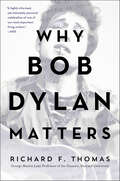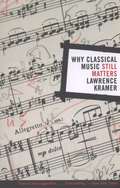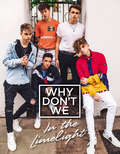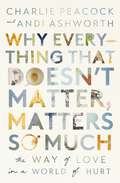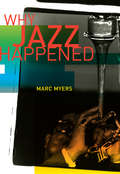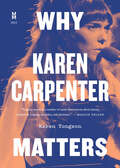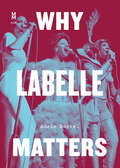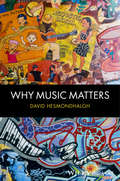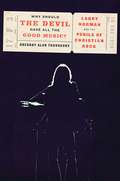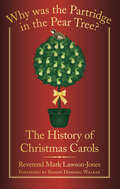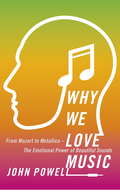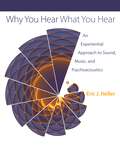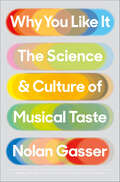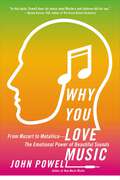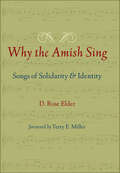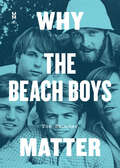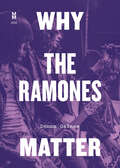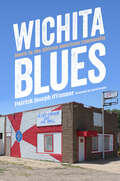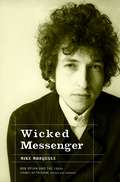- Table View
- List View
Why Bob Dylan Matters
by Richard F. Thomas“Masterful, fun . . . Thomas shows why Dylan deserves his Nobel—and how he hearkens back to, and enlists, the classics. Fantastic reading, full of gems.” —Cass R. Sunstein, Robert Walmsley University Professor, Harvard UniversityWhen the Nobel Prize for Literature was awarded to Bob Dylan in 2016, a debate raged. Some celebrated, while many others questioned the choice. How could the world’s most prestigious book prize be awarded to a famously cantankerous singer-songwriter who wouldn’t even deign to attend the medal ceremony?In Why Bob Dylan Matters, Harvard Professor Richard F. Thomas answers this question with magisterial erudition. A world expert on Classical poetry, Thomas was initially ridiculed by his colleagues for teaching a course on Bob Dylan alongside his traditional seminars on Homer, Virgil, and Ovid. Dylan’s Nobel Prize brought him vindication, and he immediately found himself thrust into the spotlight as a leading academic voice in all matters Dylanological. Today, through his wildly popular Dylan seminar—affectionately dubbed “Dylan 101” —Thomas is introducing a new generation of fans and scholars to the revered bard’s work.This witty, personal volume is a distillation of Thomas’s famous course, and makes a compelling case for moving Dylan out of the Rock & Roll Hall of Fame and into the pantheon of Classical poets. Asking us to reflect on the question, “What makes a classic?”, Thomas offers an eloquent argument for Dylan’s modern relevance, while interpreting and decoding Dylan’s lyrics for readers. The most original and compelling volume on Dylan in decades, Why Bob Dylan Matters will illuminate Dylan’s work for the Dylan neophyte and the seasoned fanatic alike. You’ll never think about Bob Dylan in the same way again.“The coolest class on campus.” —The New York Times
Why Classical Music Still Matters
by Lawrence Kramer"What can be done about the state of classical music?" Lawrence Kramer asks in this elegant, sharply observed, and beautifully written extended essay. Classical music, whose demise has been predicted for at least a decade, has always had its staunch advocates, but in today's media-saturated world there are real concerns about its viability. Why Classical Music Still Matters takes a forthright approach by engaging both skeptics and music lovers alike. In seven highly original chapters, Why Classical Music Still Matters affirms the value of classical music--defined as a body of nontheatrical music produced since the eighteenth century with the single aim of being listened to--by revealing what its values are: the specific beliefs, attitudes, and meanings that the music has supported in the past and which, Kramer believes, it can support in the future. Why Classical Music Still Matters also clears the air of old prejudices. Unlike other apologists, whose defense of the music often depends on arguments about the corrupting influence of popular culture, Kramer admits that classical music needs a broader, more up-to-date rationale. He succeeds in engaging the reader by putting into words music's complex relationship with individual human drives and larger social needs. In prose that is fresh, stimulating, and conversational, he explores the nature of subjectivity, the conquest of time and mortality, the harmonization of humanity and technology, the cultivation of attention, and the liberation of human energy.
Why Don't We: In the Limelight
by Why Don'T WeIn the Limelight is the official Why Don’t We autobiography, full of never-before-seen photos and behind-the-scenes info about one of today’s hottest bands.When five guys decided to form a band, they never imagined that they would go from playing music online to playing tours across the world so quickly. Why Don’t We has been together for less than two years, and they’ve already headlined sold out shows, played at Madison Square Garden, and amassed millions of fans. And this is all just the beginning.This is the official Why Don’t We story, full of never-before-seen photos and everything you need to know about Corbyn, Daniel, Zach, Jonah, and Jack. Find out the secrets they’ve never shared with fans before, their embarrassing childhood stories, what they look for in a girlfriend, and how it felt to have their lives completely changed by this incredible journey.
Why Everything That Doesn't Matter, Matters So Much: The Way of Love in a World of Hurt
by Charlie Peacock Andi AshworthA hopeful and practical model for what it means to be a Christian and a culture-maker in a world of hurt and wondrous possibility, from multi–Grammy winner Charlie Peacock and his wife and author, Andi Ashworth.Do you feel powerless and overwhelmed by the pain and suffering all around you? Have you ever asked, What can I do to mend the world, my family, or my own life? And if I could, why bother? Does my own small part even matter? If so, here comes hope from two guides who are further down the road. Charlie and Andi have written a collection of letters to Christians and spiritual seekers who think deeply and care acutely about the state of the world and their personal spheres of influence.In Why Everything That Doesn't Matter, Matters So Much, beloved and trusted mentors, Charlie and Andi offer you:Thought-provoking explorations into the many facets of Christian culture care and making, from the kitchen to Carnegie Hall.Practical guidance for how to care for and improve the quality of human life, locally and globally, no matter your vocation.A theology of imagination and creativity that provides a framework for all of life.A model for expressing love in marriage, friendship, citizenship, and every kind of work—even in the midst of cynicism, fear, exhaustion, and oppression. It might be said of Christians that our lives are either moving in the direction of the redemption Jesus has on offer, or away from it. Each of these letters is a gentle nudge in the direction of God's powerfully ordinary purpose for each of us, no matter what the future holds, to participate fully in the beautiful, redemptive work of Christ.
Why Jazz Happened
by Marc MyersWhy Jazz Happened is the first comprehensive social history of jazz. It provides an intimate and compelling look at the many forces that shaped this most American of art forms and the many influences that gave rise to jazz's post-war styles. Rich with the voices of musicians, producers, promoters, and others on the scene during the decades following World War II, this book views jazz's evolution through the prism of technological advances, social transformations, changes in the law, economic trends, and much more. In an absorbing narrative enlivened by the commentary of key personalities, Marc Myers describes the myriad of events and trends that affected the music's evolution, among them, the American Federation of Musicians strike in the early 1940s, changes in radio and concert-promotion, the introduction of the long-playing record, the suburbanization of Los Angeles, the Civil Rights movement, the "British invasion" and the rise of electronic instruments. This groundbreaking book deepens our appreciation of this music by identifying many of the developments outside of jazz itself that contributed most to its texture, complexity, and growth.
Why Karen Carpenter Matters (Music Matters)
by Karen TongsonA Pitchfork Best Music Book of 2019: A look at what the beloved pop singer meant to fans, written with “nostalgic affection and astute critical thinking” (Los Angeles Times).In the ’60s and ’70s, America's music scene was marked by raucous excess, reflected in the tragic overdoses of young superstars such as Jimi Hendrix and Janis Joplin. At the same time, the uplifting harmonies and sunny lyrics that propelled Karen Carpenter and her brother, Richard, to international fame belied a different sort of tragedy—the underconsumption that led to Karen’s death at age thirty-two from the effects of an eating disorder.In Why Karen Carpenter Matters, Karen Tongson (whose Filipino musician parents named her after the pop icon) interweaves the story of the singer’s rise to fame with her own trans-Pacific journey between the Philippines—where imitations of American pop styles flourished—and Karen Carpenter’s home ground of Southern California. Tongson reveals why the Carpenters’ chart-topping, seemingly whitewashed musical fantasies of “normal love” can now have profound significance for her—as well as for other people of color, LGBT+ communities, and anyone outside the mainstream culture usually associated with Karen Carpenter’s legacy. This hybrid of memoir and biography excavates the destructive perfectionism at the root of the Carpenters’ sound, while finding the beauty in the singer’s all too brief life.
Why Karen Carpenter Matters (Music Matters)
by Karen TongsonA Pitchfork Best Music Book of 2019: A look at what the beloved pop singer meant to fans, written with “nostalgic affection and astute critical thinking” (Los Angeles Times).In the ’60s and ’70s, America's music scene was marked by raucous excess, reflected in the tragic overdoses of young superstars such as Jimi Hendrix and Janis Joplin. At the same time, the uplifting harmonies and sunny lyrics that propelled Karen Carpenter and her brother, Richard, to international fame belied a different sort of tragedy—the underconsumption that led to Karen’s death at age thirty-two from the effects of an eating disorder.In Why Karen Carpenter Matters, Karen Tongson (whose Filipino musician parents named her after the pop icon) interweaves the story of the singer’s rise to fame with her own trans-Pacific journey between the Philippines—where imitations of American pop styles flourished—and Karen Carpenter’s home ground of Southern California. Tongson reveals why the Carpenters’ chart-topping, seemingly whitewashed musical fantasies of “normal love” can now have profound significance for her—as well as for other people of color, LGBT+ communities, and anyone outside the mainstream culture usually associated with Karen Carpenter’s legacy. This hybrid of memoir and biography excavates the destructive perfectionism at the root of the Carpenters’ sound, while finding the beauty in the singer’s all too brief life.
Why Labelle Matters (Music Matters)
by Adele Bertei&“A smart, shrewd, joyful read, as piercing as any top C shriek from the woman who gave Labelle their name.&” —Barney Hoskyns, author of Glam! Bowie, Bolan, and the Glitter Rock Revolution Performing as the Bluebelles in the 1960s, Patti LaBelle, Nona Hendryx, and Sarah Dash wore bouffant wigs and chiffon dresses, and they harmonized vocals like many other girl groups of the era. After a decade on the Chitlin Circuit, however, they were ready to write their own material, change their name, and deliver—as Labelle—an electrifyingly celestial sound and styling that reached a crescendo with a legendary performance at the Metropolitan Opera House to celebrate the release of Nightbirds and its most well-known track, &“Lady Marmalade.&” In Why Labelle Matters, Adele Bertei tells the story of the group that sang the opening aria of Afrofuturism and proclaimed a new theology of musical liberation for women, people of color, and LGBTQ people across the globe. With sumptuous and galactic costumes, genre-bending lyrics, and stratospheric vocals, Labelle&’s out-of-this-world performances changed the course of pop music and made them the first Black group to grace the cover of Rolling Stone. Why Labelle Matters, informed by interviews with members of the group as well as Bertei&’s own experience as a groundbreaking musician, is the first cultural assessment of this transformative act.</
Why Labelle Matters (Music Matters)
by Adele Bertei&“A smart, shrewd, joyful read, as piercing as any top C shriek from the woman who gave Labelle their name.&” —Barney Hoskyns, author of Glam! Bowie, Bolan, and the Glitter Rock Revolution Performing as the Bluebelles in the 1960s, Patti LaBelle, Nona Hendryx, and Sarah Dash wore bouffant wigs and chiffon dresses, and they harmonized vocals like many other girl groups of the era. After a decade on the Chitlin Circuit, however, they were ready to write their own material, change their name, and deliver—as Labelle—an electrifyingly celestial sound and styling that reached a crescendo with a legendary performance at the Metropolitan Opera House to celebrate the release of Nightbirds and its most well-known track, &“Lady Marmalade.&” In Why Labelle Matters, Adele Bertei tells the story of the group that sang the opening aria of Afrofuturism and proclaimed a new theology of musical liberation for women, people of color, and LGBTQ people across the globe. With sumptuous and galactic costumes, genre-bending lyrics, and stratospheric vocals, Labelle&’s out-of-this-world performances changed the course of pop music and made them the first Black group to grace the cover of Rolling Stone. Why Labelle Matters, informed by interviews with members of the group as well as Bertei&’s own experience as a groundbreaking musician, is the first cultural assessment of this transformative act.
Why Music Matters
by David HesmondhalghListen to David Hesmondhalgh discuss the arguments at the core of 'Why Music Matters' with Laurie Taylor on BBC Radio 4's Thinking Allowed here.In what ways might music enrich the lives of people and of societies? What prevents it from doing so? Why Music Matters explores the role of music in our lives, and investigates the social and political significance of music in modern societies.First book of its kind to explore music through a variety of theories and approaches and unite these theories using one authoritative voiceCombines a broad yet theoretically sophisticated approach to music and society with real clarity and accessibilityA historically and sociologically informed understanding of music in relation to questions of social power and inequalityBy drawing on both popular and academic talk about a range of musical forms and practices, readers will engage with a wide musical terrain and a wealth of case studies
Why Should the Devil Have All the Good Music?: Larry Norman and the Perils of Christian Rock
by Gregory ThornburyThe riveting, untold story of the “Father of Christian Rock” and the conflicts that launched a billion-dollar industry at the dawn of America’s culture wars. In 1969, in Capitol Records' Hollywood studio, a blonde-haired troubadour named Larry Norman laid track for an album that would launch a new genre of music and one of the strangest, most interesting careers in modern rock. Having spent the bulk of the 1960s playing on bills with acts like the Who, Janis Joplin, and the Doors, Norman decided that he wanted to sing about the most countercultural subject of all: Jesus. Billboard called Norman “the most important songwriter since Paul Simon,” and his music would go on to inspire members of bands as diverse as U2, The Pixies, Guns ‘N Roses, and more. To a young generation of Christians who wanted a way to be different in the American cultural scene, Larry was a godsend—spinning songs about one’s eternal soul as deftly as he did ones critiquing consumerism, middle-class values, and the Vietnam War. To the religious establishment, however, he was a thorn in the side; and to secular music fans, he was an enigma, constantly offering up Jesus to problems they didn’t think were problems. Paul McCartney himself once told Larry, “You could be famous if you’d just drop the God stuff,” a statement that would foreshadow Norman’s ultimate demise. In Why Should the Devil Have all the Good Music?, Gregory Alan Thornbury draws on unparalleled access to Norman’s personal papers and archives to narrate the conflicts that defined the singer’s life, as he crisscrossed the developing fault lines between Evangelicals and mainstream American culture—friction that continues to this day. What emerges is a twisting, engrossing story about ambition, art, friendship, betrayal, and the turns one’s life can take when you believe God is on your side.
Why Was the Partridge in the Pear Tree?: The History of Christmas Carols
by Mark Lawson-Jones Dominic WalkerWhy was the partridge in the pear tree? Who was Good King Wenceslas? And what are the pagan origins behind ‘The Holly and the Ivy’? Discover the hidden stories behind our best-loved Christmas carols, from their earliest incarnations in the Middle Ages and their banning under the Puritans to the wassailing traditions of the nineteenth century and the carols that united soldiers on the Western Front during the First World War. This fascinating book charts the history of one of Christmas’ longest-running traditions and is sure to appeal to all those who love the festive season.
Why We Left: Untold Stories and Songs of America's First Immigrants
by Joanna BrooksA grounded, tender, and mournful reckoning with the catastrophes that launched poor, white Anglos into their role as itinerant foot soldiers for modern imperialism—now in paperback with a new preface Joanna Brooks&’s ancestors were among the early waves of emigrants to leave England for North America. For generations, they lived hardscrabble lives, eking out subsistence in one place after another as they continually moved west in search of a better life. Why, Brooks wondered, did her people and countless other poor English subjects abandon their homeland for such unremitting hardship? The question leads her on a journey through an obscure dimension of American history. Why We Left reveals the violence and dislocation that propelled seventeenth- and eighteenth-century working-class English emigration, presenting a powerful restorying of how we arrived at our present moment of precarity and rootlessness. Following American folk ballads back across the Atlantic to find histories of economic displacement, environmental destruction, and social betrayal at the heart of the early Anglo-American migrant experience, Brooks offers a scholarly and personal account of the intergenerational traumas that shape the history of white Anglos on Turtle Island. She shares folk ballads such as &“Edward,&” which reveals the influence of deforestation on the dislocation of early Anglo-American peasant immigrants, and &“The House Carpenter&’s Wife,&” which emphasizes the impact of economic instability and the colonial enterprise on women. From these ballads, tragic and heartrending, Brooks uncovers an archaeology of the worldviews of America&’s earliest immigrants. This tenth-anniversary edition includes a new preface and develops a haunting historical perspective on the ancestors we thought we knew.
Why We Love Music: From Mozart to Metallica - The Emotional Power of Beautiful Sounds
by Dr John PowellDid you know that . . .carrying a musical instrument makes you more attractive?music can cure insomnia?music can change the taste of wine?the Mozart effect has nothing to do with Mozart?Barry Manilow songs can be used for crowd control?Why does music affect you so profoundly? It impacts the way you think, talk, feel, behave and even spend money. With his conversational style, humour, and endless knowledge, scientist and musician John Powell showcases fascinating studies - for example that shoppers spend more money in stores that play classical music and, even more astounding, they are more likely to buy German wine in stores playing German music. With chapters on music and emotions, music as medicine, music and intelligence, and much more, Why We Love Music will entertain through to the very last page. A delightful journey through the psychology and science of music, Why We Love Music is the perfect book for anyone who loves a tune.
Why We Love Music: From Mozart to Metallica - The Emotional Power of Beautiful Sounds
by Dr John PowellWhy does music affect you so profoundly? It impacts the way you think, talk, feel, behave and even spend money. With his conversational style, humour, and endless knowledge, scientist and musician John Powell showcases fascinating studies - for example that shoppers spend more money in stores that play classical music and, even more astounding, they are more likely to buy German wine in stores playing German music. With chapters on music and emotions, music as medicine, music and intelligence, and much more, Why We Love Music will entertain through to the very last page. A delightful journey through the psychology and science of music, Why We Love Music is the perfect book for anyone who loves a tune.
Why You Hear What You Hear: An Experiential Approach to Sound, Music, and Psychoacoustics
by Eric J. HellerA groundbreaking textbook that explores the phenomena and physics of music and soundWhy You Hear What You Hear is the first book on the physics of sound for the nonspecialist to empower readers with a hands-on, ears-open approach that includes production, analysis, and perception of sound. The book makes possible a deep intuitive understanding of many aspects of sound, as opposed to the usual approach of mere description. This goal is aided by hundreds of original illustrations and examples, many of which the reader can reproduce and adjust using the same tools used by the author (e.g., very accessible applets for PC and Mac, and interactive web-based examples, simulations, and analysis tools that can be found on the book's website: whyyouhearwhatyouhear.com). Readers are positioned to build intuition by participating in discovery.This truly progressive introduction to sound engages and informs amateur and professional musicians, performers, teachers, sound engineers, students of many stripes, and indeed anyone interested in the auditory world. The book does not hesitate to follow entertaining and sometimes controversial side trips into the history and world of acoustics, reinforcing key concepts. You will discover how musical instruments really work, how pitch is perceived, and how sound can be amplified with no external power source.Sound is key to our lives, and is the most accessible portal to the vibratory universe. This book takes you there.The first book on sound to offer interactive tools, building conceptual understanding via an experiential approachSupplementary website (http://www.whyyouhearwhatyouhear.com) provides Java, MAX, and other free, multiplatform, interactive graphical and sound appletsExtensive selection of original exercises available on the web with solutionsNearly 400 full-color illustrations, many of simulations that students can do
Why You Like It: The Science & Culture of Musical Taste
by Nolan GasserFrom the chief architect of the Pandora Radio’s Music Genome Project comes a definitive and groundbreaking examination of why we respond to music the way we do.Everyone loves music. But what is it that makes music so universally beloved and have such a powerful effect on us? In this sweeping and authoritative book, Dr. Nolan Gasser—a composer, pianist, and musicologist, and the chief architect of the Music Genome Project, which powers Pandora Radio—breaks down what musical taste is, where it comes from, and what our favorite songs say about us. Dr. Gasser delves into the science, psychology, and sociology that explains why humans love music so much; how our brains process music; and why you may love Queen but your best friend loves Kiss. He sheds light on why babies can clap along to rhythmic patterns and reveals the reason behind why different cultures around the globe identify the same kinds of music as happy, sad, or scary. Using easy-to-follow notated musical scores, Dr. Gasser teaches music fans how to become engaged listeners and provides them with the tools to enhance their musical preferences. He takes readers under the hood of their favorite genres—pop, rock, jazz, hip hop, electronica, world music, and classical—and covers songs from Taylor Swift to Led Zeppelin to Kendrick Lamar to Bill Evans to Beethoven, and through their work, Dr. Gasser introduces the musical concepts behind why you hum along, tap your foot, and feel deeply. Why You Like It will teach you how to follow the musical discourse happening within a song and thereby empower your musical taste, so you will never hear music the same way again.
Why You Love Music: From Mozart to Metallica--The Emotional Power of Beautiful Sounds
by John PowellA delightful journey through the psychology and science of music, WHY YOU LOVE MUSIC is the perfect book for anyone who loves a tune.Music plays a hugely important role in our emotional, intellectual, and even physical lives. It impacts the ways we work, relax, behave, and feel. It can make us smile or cry, it helps us bond with the people around us, and it even has the power to alleviate a range of medical conditions. The songs you love (and hate, and even the ones you feel pretty neutral about) don't just make up the soundtrack to your life--they actually help to shape it. In WHY YOU LOVE MUSIC, scientist and musician John Powell dives deep into decades of psychological and sociological studies in order to answer the question "Why does music affect us so profoundly?" With his relaxed, conversational style, Powell explores all aspects of music psychology, from how music helps babies bond with their mothers to the ways in which music can change the taste of wine or persuade you to spend more in restaurants. WHY YOU LOVE MUSIC will open your eyes (and ears) to the astounding variety of ways that music impacts the human experience.
Why the Amish Sing: Songs of Solidarity and Identity (Young Center Books in Anabaptist and Pietist Studies)
by D. Rose ElderAn intimate portrait of the diverse music-making at the center of Amish faith and life.Singing occurs in nearly every setting of Amish life. It is a sanctioned pleasure that frames all Amish rituals and one that enlivens and sanctifies both routine and special events, from household chores, road trips by buggy, and family prayer to baptisms, youth group gatherings, weddings, and "single girl" sings. But because Amish worship is performed in private homes instead of public churches, few outsiders get the chance to hear Amish people sing. Amish music also remains largely unexplored in the field of ethnomusicology. In Why the Amish Sing, D. Rose Elder introduces readers to the ways that Amish music both reinforces and advances spiritual life, delving deep into the Ausbund, the oldest hymnal in continuous use. This illuminating ethnomusicological study demonstrates how Amish groups in Wayne and Holmes Counties, Ohio—the largest concentration of Amish in the world—sing to praise God and, at the same time, remind themselves of their 450-year history of devotion. Singing instructs Amish children in community ways and unites the group through common participation. As they sing in unison to the weighty words of their ancestors, the Amish confirm their love and support for the community. Their singing delineates their common journey—a journey that demands separation from the world and yielding to God's will.By making school visits, attending worship services and youth sings, and visiting private homes, Elder has been given the rare opportunity to listen to Amish singing in its natural social and familial context. She combines one-on-one interviews with detailed observations of how song provides a window into Amish cultural beliefs, values, and norms.
Why the Beach Boys Matter (Music Matters)
by Tom Smucker“An excellent introduction to the band that might have evolved, [the author] suggests, into the Beatles.” ?New York Journal of BooksOf all the white American pop music groups that hit the charts before the Beatles, only the Beach Boys continued to thrive throughout the British Invasion to survive into the 1970s and beyond. The Beach Boys helped define both sides of the era we broadly call the sixties, split between their early surf, car, and summer pop and their later hippie, counterculture, and ambitious rock. No other group can claim the Ronettes and the Four Seasons as early 1960s rivals; the Mamas and the Papas and Crosby, Stills and Nash as later 1960s rivals; and the Beatles and the Temptations as decade-spanning counterparts.This is the first book to take an honest look at the themes running through the Beach Boys’ art and career as a whole and to examine where they sit inside our culture and politics—and why they still grab our attention.
Why the Beach Boys Matter (Music Matters)
by Tom Smucker&“An excellent introduction to the band that might have evolved, [the author] suggests, into the Beatles.&” —New York Journal of Books Of all the white American pop music groups that hit the charts before the Beatles, only the Beach Boys continued to thrive throughout the British Invasion to survive into the 1970s and beyond. The Beach Boys helped define both sides of the era we broadly call the sixties, split between their early surf, car, and summer pop and their later hippie, counterculture, and ambitious rock. No other group can claim the Ronettes and the Four Seasons as early 1960s rivals; the Mamas and the Papas and Crosby, Stills and Nash as later 1960s rivals; and the Beatles and the Temptations as decade-spanning counterparts. This is the first book to take an honest look at the themes running through the Beach Boys&’ art and career as a whole and to examine where they sit inside our culture and politics—and why they still grab our attention.
Why the Ramones Matter (Music Matters)
by Donna Gaines&“Unequivocally fresh and engrossing. Even the biggest fans will find something new to enjoy here.&” ―Razorcake The central experience of the Ramones and their music is of being an outsider, an outcast, a person who&’s somehow defective, and the revolt against shame and self-loathing. The fans, argues Donna Gaines, got it right away, from their own experience of alienation at home, at school, on the streets, and from themselves. This sense of estrangement and marginality permeates everything the Ramones still offer us as artists, and as people. Why the Ramones Matter compellingly makes the case that the Ramones gave us everything; they saved rock and roll, modeled DIY ethics, and addressed our deepest collective traumas, from the personal to the historical.
Why the Ramones Matter (Music Matters)
by Donna Gaines&“Unequivocally fresh and engrossing. Even the biggest fans will find something new to enjoy here.&” ―Razorcake The central experience of the Ramones and their music is of being an outsider, an outcast, a person who&’s somehow defective, and the revolt against shame and self-loathing. The fans, argues Donna Gaines, got it right away, from their own experience of alienation at home, at school, on the streets, and from themselves. This sense of estrangement and marginality permeates everything the Ramones still offer us as artists, and as people. Why the Ramones Matter compellingly makes the case that the Ramones gave us everything; they saved rock and roll, modeled DIY ethics, and addressed our deepest collective traumas, from the personal to the historical.
Wichita Blues: Music in the African American Community (American Made Music Series)
by Patrick Joseph O'ConnorIn conversations on regional blues, the traditions of the Mississippi Delta, the Carolina Piedmont, Chicago, Houston, Memphis, New Orleans, and Los Angeles are frequently lauded. But until now, little attention has been paid to the Midwest, despite the presence and popularity of blues in these heartland communities. Wichita Blues: Music in the African American Community seeks to address this gap in music history by exploring the lively Wichita blues tradition. In interviews with nineteen African American Wichita blues performers, author Patrick Joseph O’Connor reveals the evolution of the blues from the 1930s to the 1960s and beyond.Utilizing twenty-five years of fieldwork, Wichita Blues details the history of performance and camaraderie among the musicians of this often-neglected regional sound. The personal interviews offer unique insight into topics that shape Wichita’s sound, including how migration from Oklahoma, Texas, and Arkansas brought varied artists to the area and the ways musical traditions cross racial divides and generations. The artists articulate the poetics of the blues and the diverse regional influences that can be detected in their music. In exploring the Wichita blues tradition, O’Connor traces African American history in Kansas, ranging from the Exoduster movement in the late nineteenth century and minstrel shows across the state to Black cowboys and growing urban African American communities in Topeka and Wichita.Including a foreword by renowned music scholar David Evans, Wichita Blues allows seasoned blues musicians to tell their own stories and paints a picture of the vibrant Black music scene in the city.
Wicked Messenger: Bob Dylan and the 1960s
by Mike MarquseeBob Dylan's abrupt abandonment of overtly political songwriting in the mid-1960s caused an uproar among critics and fans. In Wicked Messenger, acclaimed cultural-political commentator Mike Marqusee advances the new thesis that Dylan did not drop politics from his songs but changed the manner of his critique to address the changing political and cultural climate and, more importantly, his own evolving aesthetic. Wicked Messenger is also a riveting political history of the United States in the 1960s. Tracing the development of the decade's political and cultural dissent movements, Marqusee shows how their twists and turns were anticipated in the poetic aesthetic--anarchic, unaccountable, contradictory, punk-- of Dylan's mid-sixties albums, as well as in his recent artistic ventures in Chronicles, Vol. I and Masked and Anonymous. Dylan's anguished, self-obsessed, prickly artistic evolution, Marqusee asserts, was a deeply creative response to a deeply disturbing situation. "He can no longer tell the story straight," Marqusee concludes, "because any story told straight is a false one."
